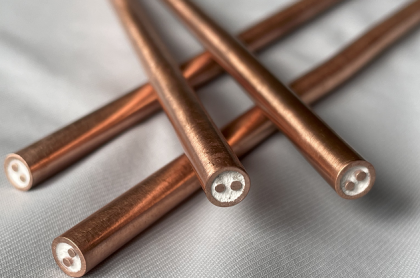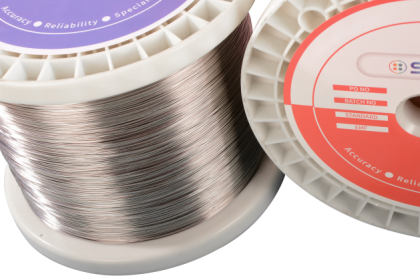1.Principle
Two conductors with different components (thermocouple wire or thermode) are joined at both ends to form a circuit. When the temperature of the junction is different, an electromotive force will be generated in the circuit. This phenomenon is called thermoelectric effect, and this electromotive force is called thermoelectric force. The end directly used to measure the temperature of the medium is called the working end (the measuring end), and the other end is called the cold end (the compensation end); the cold end is connected to the display instrument or supporting instrument, and the display instrument will indicate the thermoelectric potential generated by the thermocouple.
Thermocouple is actually a kind of energy converter, which converts thermal energy into electrical energy, using the generated thermoelectric potential to measure temperature. For the thermoelectric potential, the following issues should be paid attention to:
(1) The thermoelectric potential is the temperature function difference between the two ends of the thermocouple working end, not the function of the temperature difference between the cold end and the working end of the thermocouple;
(2) The magnitude of the thermal potential generated by a thermocouple, when the material is homogeneous, has nothing to do with the length and diameter of the thermocouple, but only with the composition of the material and the temperature difference between the two ends;
(3) When the material composition of the two thermocouple wires is determined, the thermoelectric potential is only related to the temperature difference of the thermocouple; if the temperature of the cold end is kept constant, the thermoelectric potential of the thermocouple is only a single-valued function of the temperature of the working end. Solder two conductors or semiconductors of different materials to form a closed circuit. When there is a temperature difference between the two attachment points, an electromotive force is generated between the two, thus forming a large and small current in the circuit. This phenomenon is called the thermoelectric effect. Thermocouple uses this effect to work.
1. Function
Thermocouple is the most widely used temperature device in temperature measurement. Its main features are wide temperature measurement range, relatively stable performance, simple structure, good dynamic response, and the ability to transmit 4~20mA electrical signals remotely, which is convenient for automatic control and centralized control. The principle of thermocouple temperature measurement is based on the thermoelectric effect.
The thermoelectric potential generated in the closed loop consists of two potentials; thermoelectric potential and contact potential. Thermoelectric potential refers to the potential generated by the two ends of the same conductor due to different temperatures. Different conductors have different electron densities, so they generate different potentials. As the name implies, the contact potential refers to when two different conductors are in contact. Because their electron densities are different, a certain amount of electron diffusion occurs.
At present, there is a standard specification for thermocouple used in the world. Internationally, thermocoupleis divided into eight different divisions, namely B, R, S, K, N, E, J and T. The lowest temperature can be measured at minus 270°C and the highest can reach 1800°C. Among them, B, R, and S belong to platinum series thermocouple. Because platinum is a heavy metal, they are also called noble metal thermocouple and the rest are called cheap metal thermocouple. There are two types of thermocouple structures, common type andMI type.Common type is generally composed of thermal electrodes, insulating tubes, protective sheath, and junction boxes, while MI thermocouple is a solid combination of thermocouple wires, insulating materials, and metal protective sheath that are assembled and stretched. However, the electrical signal of the thermocouple needs a special wire to transmit, and this wire is called a compensation wire. Different thermocouple requires different compensation wires, and its main function is to connect with the thermocouple so that the reference junction of the thermocouple is far away from the power supply, thereby stabilizing the temperature of the reference junction.
The compensation wire is divided into compensation type and extension type. The chemical composition of the extension wire is the same as that of the thermocouple to be compensated. However, in practice, the extension wire is not made of the same material as the thermocouple. It is generally replaced by a wire with the same electron density as the thermocouple. The connection between the compensation wire and the thermocouple is generally very clear. The positive pole is connected to the red wire of the compensation wire, and the negative pole is connected to the remaining colors. Most of the general compensating wires are made of copper-nickel alloy.
2. Type N thermocouple&its application
(1) Basic Concept
Nickel-chromium-nickel-silicon thermocouple (N type) is a standardized nickel-based alloy thermocouple with great development potential. It is a recognized international standard thermocouple, and its division is N. Its positive electrode contains 84% nickel, 14%~14.4% chromium, 1.3%~1.6% silicon, and no more than 0.1% of other elements; the negative electrode contains 95% nickel, 4.2%~4.6% silicon, and 0.5%~1.5% magnesium. N type thermal resistance is a kind of cheap metal thermocouple that can be used at 1200 °C, which is better than K type thermal resistance. It has strong oxidation resistance and is not affected by short-range ordering. N type thermocouple, like the K type thermocouple, cannot be used in alternating atmosphere of oxidation and cannot be used in vacuum.
(2) Application
Most of the main steam temperature measurements in thermal power plants in China use K type thermocouple as primary elements, and there is currently a problem of low temperature measurement accuracy. In order to improve the accuracy of main steam temperature measurement, it is an effective technical measure to replace K type thermocouple with N type thermocouple. At present, N type thermocouple has been used in thermal power plant main steam temperature measurement. It has the advantages of stable thermoelectric characteristics, long service life and small nonlinear error, which improves the accuracy of main steam temperature measurement and meets the requirements of thermal power unit operation regulations. Based on the successful application of N type thermocouple to measure the main steam temperature, it can also be used to measure the temperature of metal walls such as superheaters and cylinders.
3. Conclusion
The importance of thermocouple in industrial production is incomparable. It is precisely because of their application that our production becomes more convenient, faster and more accurate. Especially for N type thermocouple, due to its good stability and high accuracy, it has gradually replaced K type thermocouple in industrial production, so the development prospects of N type thermocouple in industrial production, especially in thermal power plants, are limitless.











 IPv6 network supported
IPv6 network supported